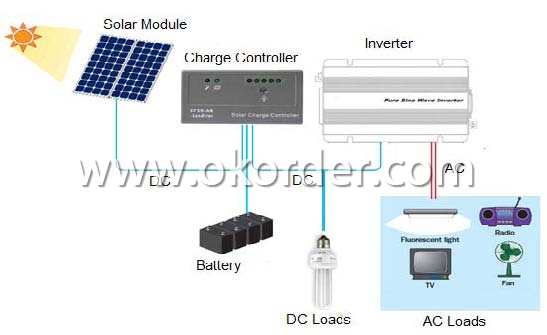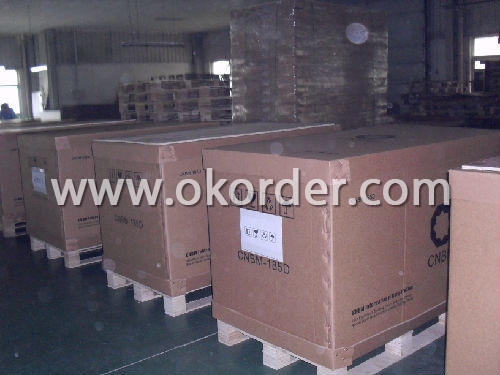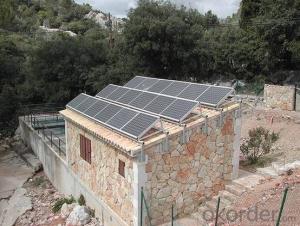CNBM Solar Home System CNBM-K6 (1KW)
- Loading Port:
- China Main Port
- Payment Terms:
- TT or L/C
- Min Order Qty:
- 1 set set
- Supply Capability:
- 1000 sets per month set/month
OKorder Service Pledge
OKorder Financial Service
You Might Also Like
Brief Introduction of Solar Energy System CNBM-K6 (1KW)
CNBM Home System-K6 (1KW) has a wonderful capacity.It can be used in factory,home,school and other CNBM Home System-K6 (1KW) consist of the solar modules,charge controller,inverter and battery banks.
CNBM International is highly recognized by its business partners and clients all over the world and has obtained rapid development under the spirit of win-win .
With CNBM Home System-K6 (1KW),
We will carry on the mutual beneficial,innovative and revolutionary trading structure as we did before,create value for our employees,share holders and clients and benefit the whole society in our future development.Please contact us ,if you have interest in CNBM Home System-K6 (1KW),don’t hesitate!
The Sketching of Solar Energy System CNBM-K6 (1KW)

Components of Solar Energy System CNBM-K6 (1KW)
PV Array:
Convert sunlight instantly into DC electric power. Formed by the solar modules (also called photovoltaic modules) in accordance with the system requirements for series and parallel.
Solar Charge Controller:
A charge controller may be used to power DC equipment with solar panels. The charge controller provides a regulated DC output and stores excess energy in a battery as well as monitoring the battery voltage to prevent over charge or over discharge. An inverter can be connected to the output of a charge controller to drive AC loads.
Inverter:
Converts DC output power of photovaltaic soalr panels into standard AC power for use in the local off-grid electrical network. It is a critical component in a photovoltaic system, allowing the use of ordinary commercial appliances.
Battery banks:
Stores energy when there is an excess coming in and distribute it back out when there is a demand. Solar PV panels continue to re-charge batteries each day to maintain battery charge.
Technical data of Solar Home System CNBM-K6 (1KW) | ||
Inverter | Rated load power | 1500W |
Output wave | Pure sine wave | |
Output voltage | DC 24V | |
Output frequency |
AC:220V | |
Precision of output | 50HZ/60HZ | |
Precision of output frequency | ±6% | |
Solar panel | Pmax | 165W*6PCS |
Vmp | 36V | |
Imp | 4.58A*6 | |
Charger | Charger voltage & current | 24V /20A*3 |
Battery | Capacity | 12V 250AH*2PCS |
Power box | Spray paint iron box,with input,output,ammeter,voltmeter,master swith and so on. | |
Package of Solar Home System CNBM-K6 (1KW) | ||||
Part | Size(L*W*H mm) | Weight(kg) | 20’(pcs) | 40’(pcs) |
Power box | 800*540*780 | 70 | 48 Sets | 65 Sets |
Solar panel | 1600*830*90 | 90 | ||
Battery | 540*520*350 | 200 | ||
Factory Picture of Solar Energy System CNBM-K6 (1KW)

Package Picture of Solar Energy System CNBM-K6 (1KW)

- Q:How long does it take to recoup the cost of installing a solar energy system?
- The length of time it takes to recoup the cost of installing a solar energy system can vary depending on various factors, including the initial cost of the system, the amount of electricity the system generates, and the cost of electricity from the grid. On average, it typically takes around 5 to 10 years to recoup the upfront investment of a solar energy system. However, this time frame can be shorter or longer depending on the specific circumstances. One of the key factors influencing the payback period is the cost of electricity from the grid. If electricity prices are high, the solar system can offset a larger portion of the electricity bill, leading to quicker payback. Additionally, the availability of government incentives and tax credits can significantly reduce the initial cost and shorten the payback period. The amount of electricity generated by the solar system also plays a crucial role. A larger system that generates more electricity will offset a greater portion of the electricity bill, accelerating the payback period. Another consideration is the location and local climate. Regions with ample sunlight and higher electricity costs tend to have shorter payback periods. Additionally, the presence of net metering programs, where excess energy generated by the system can be sold back to the grid, can further shorten the time it takes to recoup the investment. It's important to note that while the payback period is an important aspect of evaluating the financial feasibility of a solar energy system, it is just one factor to consider. Solar energy systems have long lifespans, typically around 25 to 30 years, during which they can continue to generate free and clean electricity, providing significant savings and environmental benefits beyond the payback period.
- Q:Can solar energy systems be used for powering electric battery manufacturing plants?
- Electric battery manufacturing plants can use solar energy systems to power their operations. Solar energy is a renewable and clean source that can be converted into electricity through photovoltaic (PV) panels. These panels capture sunlight and convert it into usable electricity. This electricity can then be utilized in various industrial processes, including electric battery manufacturing. To implement solar energy systems, manufacturing plants can install PV panels on their rooftops or in nearby open spaces. This allows them to directly power their operations, reducing their dependence on fossil fuel-based power and lowering greenhouse gas emissions. Additionally, any excess electricity generated can be stored in batteries for later use, ensuring a steady power supply even during periods of low sunlight. By embracing solar energy systems, electric battery manufacturing plants can make significant strides in reducing their carbon footprint and contributing to a more sustainable energy future. This not only supports global efforts against climate change but also helps in cutting down operational costs associated with traditional power sources.
- Q:How do solar energy systems affect water usage?
- Solar energy systems have a minimal impact on water usage compared to other forms of electricity generation. Unlike conventional power plants that rely heavily on water for cooling and steam generation, solar energy systems do not require water for their operation. This makes solar energy an environmentally friendly and sustainable alternative that conserves water resources.
- Q:Can solar energy systems be used in all climates?
- Solar energy systems can be used in various climates, but their efficiency and performance may vary. While solar panels can still generate electricity in colder or cloudier climates, their output may be lower compared to sunny regions. However, advancements in technology and the use of more efficient solar panels have made it possible to harness solar energy in a wider range of climates, making it a viable and sustainable option for many locations around the world.
- Q:How do solar energy systems impact wildlife?
- Solar energy systems can have both positive and negative impacts on wildlife. On the positive side, they offer renewable energy, reducing the need for fossil fuels and reducing air and water pollution. Additionally, solar panels can provide shelter and shade for certain species. However, there are also negative impacts to consider. Large-scale solar projects can lead to habitat destruction, displacement of wildlife, and disruption of migration patterns. Additionally, the glare from solar panels can disorient birds and insects. To minimize these impacts, it is crucial to carefully plan and design solar projects, considering the needs and habitats of local wildlife.
- Q:Can solar energy systems be used in powering agricultural processing facilities?
- Yes, solar energy systems can be used to power agricultural processing facilities. Solar energy systems, such as photovoltaic (PV) panels, can generate electricity from sunlight, which can then be used to power various electrical equipment and processes in agricultural processing facilities. This can include powering machinery used for cleaning, sorting, and packaging agricultural products, as well as running heating, ventilation, and air conditioning systems. Solar energy systems can also be integrated with battery storage solutions to provide a reliable and continuous power supply, even during periods of low sunlight or at night. Additionally, using solar energy to power agricultural processing facilities can help reduce reliance on fossil fuels, lower greenhouse gas emissions, and contribute to a more sustainable and environmentally friendly operation.
- Q:Can solar energy systems be used for heating and cooling buildings?
- Heating and cooling buildings can indeed be accomplished using solar energy systems. These systems, including solar thermal systems and photovoltaic (PV) systems, can be employed to offer heating and cooling solutions for buildings. Solar thermal systems capture the sun's heat and convert it into usable thermal energy. This energy can be utilized for space heating, water heating, and even for cooling purposes. In the case of a solar thermal heating system, solar collectors are placed on the roof or façade of a building to capture the sun's heat. This heat is then transferred to a heat exchanger or heat storage system, which can be utilized to warm the building during colder periods. Similarly, solar thermal cooling systems harness the sun's heat to power absorption chillers or desiccant cooling systems. These systems utilize the heat energy to drive a refrigeration cycle, which cools the air inside a building. Solar thermal cooling systems are especially effective in hot climates with high cooling demands, as they decrease reliance on traditional air conditioning systems. Additionally, PV systems can indirectly contribute to the heating and cooling of buildings. By generating electricity from sunlight, PV systems can power electric heating or cooling devices, such as heat pumps and air conditioners. While PV systems are primarily known for generating electricity, this electricity can be used to operate heating and cooling systems, thereby reducing the need for fossil fuel-based methods. To sum up, solar energy systems can be utilized for both heating and cooling buildings. Whether through solar thermal systems directly capturing the sun's heat or PV systems indirectly powering heating and cooling devices, solar energy offers sustainable and environmentally friendly solutions for heating and cooling buildings.
- Q:Can solar energy systems be installed in areas with extreme weather conditions?
- Yes, solar energy systems can be installed in areas with extreme weather conditions. However, the performance and durability of the system may vary depending on the specific weather conditions. Proper design, installation, and maintenance can help ensure that solar systems can withstand extreme weather events such as hurricanes, snowstorms, or high winds. Additionally, advancements in solar technology have made it possible to adapt systems to various weather conditions, making solar energy a viable option in areas with extreme weather.
- Q:Can solar energy systems be used for powering disaster relief efforts?
- Yes, solar energy systems can be used for powering disaster relief efforts. Solar power provides a reliable and sustainable source of energy, especially in areas where the conventional power grid may be disrupted or unavailable due to a disaster. Solar energy systems can be quickly deployed and can provide electricity to power medical facilities, communication systems, lighting, and other essential equipment during relief operations. They are also cost-effective in the long run and reduce dependency on fossil fuels, making solar energy an ideal solution for disaster-affected areas.
- Q:What are the advantages of solar energy systems?
- There are several advantages of solar energy systems. Firstly, solar energy is a renewable source of energy, meaning it will never run out as long as the sun continues to shine. This is in stark contrast to fossil fuels, which are finite resources and are being depleted at an alarming rate. Secondly, solar energy is environmentally friendly. Unlike fossil fuels, solar energy systems do not emit harmful greenhouse gases or pollutants that contribute to climate change and air pollution. This makes solar energy a clean and sustainable alternative that helps in reducing our carbon footprint and mitigating the negative effects of global warming. Additionally, solar energy systems can significantly reduce electricity bills. Once the initial investment in installing solar panels is made, the cost of harnessing solar energy is relatively low. Solar energy is free, and the only cost incurred is the maintenance and occasional repair of the equipment. This can lead to substantial long-term savings on energy bills, especially as the cost of traditional electricity continues to rise. Moreover, solar energy systems can provide energy independence. By generating your own electricity, you are less reliant on utility companies and the fluctuating prices of fossil fuels. This independence also provides a level of energy security, as solar energy systems are not vulnerable to supply disruptions or price fluctuations caused by geopolitical tensions or natural disasters. Lastly, the installation of solar energy systems stimulates local economies and job creation. The solar industry has experienced significant growth in recent years, leading to the creation of numerous jobs in manufacturing, installation, and maintenance. This not only boosts the economy but also provides employment opportunities in a rapidly expanding sector. In conclusion, the advantages of solar energy systems are numerous. From being a renewable and environmentally friendly source of energy to reducing electricity bills, providing energy independence, and creating jobs, solar energy is a viable and sustainable solution for our energy needs.
1. Manufacturer Overview |
|
|---|---|
| Location | Ningbo,China |
| Year Established | 2004 |
| Annual Output Value | Above US$0.3 Billion |
| Main Markets | Australia;Europe. |
| Company Certifications | ISO9001:2008;VDE;CE |
2. Manufacturer Certificates |
|
|---|---|
| a) Certification Name | |
| Range | |
| Reference | |
| Validity Period | |
3. Manufacturer Capability |
|
|---|---|
| a)Trade Capacity | |
| Nearest Port | Ningbo |
| Export Percentage | 0.4 |
| No.of Employees in Trade Department | 10 People |
| Language Spoken: | English;Chinese; |
| b)Factory Information | |
| Factory Size: | Above 4,000 square meters |
| No. of Production Lines | Above 5 |
| Contract Manufacturing | OEM Service Offered;Design Service Offered |
| Product Price Range | Average |
Send your message to us
CNBM Solar Home System CNBM-K6 (1KW)
- Loading Port:
- China Main Port
- Payment Terms:
- TT or L/C
- Min Order Qty:
- 1 set set
- Supply Capability:
- 1000 sets per month set/month
OKorder Service Pledge
OKorder Financial Service
Similar products
New products
Hot products
Hot Searches
Related keywords




























